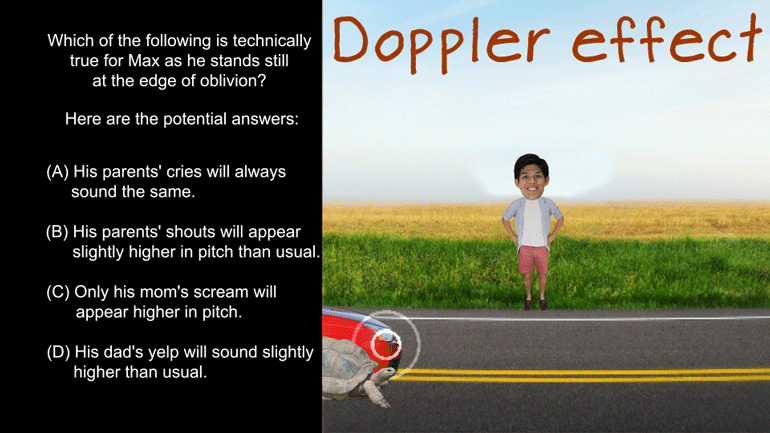ShmoopTube
Where Monty Python meets your 10th grade teacher.
Search Thousands of Shmoop Videos
AP Physics 1: 2.5 System Interactions and Changes 171 Views
Share It!
Description:
AP Physics 1: System Interactions and Changes Drill 2, Problem 5. Which of the following measurements is needed?
Transcript
- 00:02
All right here's your Shmoop du jour brought to you by skateboarders. They may
- 00:07
not want you to know it but they're actually physicists in training. Check [Skateboarder does a trick]
- 00:11
out the following diagram dude.. All right a ball rolls down the ramp shown above, a
- 00:16
group of students are tasked with measuring the total energy of the system. [Diagram of the experiment]
- 00:21
Which of the following measurements do they need, select two answers. And here
Full Transcript
- 00:25
the options. (Quickly reads through the text) Well they're all kinds of
- 00:30
energy, potential energy, kinetic energy, nuclear energy and the most powerful of [Examples of the energy types are shown]
- 00:34
all sugared up little-kid energy! To find the total energy [Kids running round a garden]
- 00:39
of a system we need to take its potential energy and its kinetic energy
- 00:43
and add those up to show the total mechanical energy. Well we can see that
- 00:47
there's a relationship between these two forms of energy and in an isolated [Two people with 'potential energy' and 'kinetic energy' tshirts on]
- 00:51
system the total energy cannot change. It's called the law of conservation of energy
- 00:55
and even the best legal team in the world couldn't help us break that law. [Judge uses a gavel]
- 00:58
Now we know that if kinetic energy in the system increases the potential [People on a roller coaster]
- 01:03
energy has to decrease and vice versa. Well simplify this question which is
- 01:08
always our goal we can minimize the kinetic energy and maximize the [Big guy with 'potential energy' tattooed on his chest]
- 01:13
potential energy. So if we just focus on the potential energy of this system when
- 01:17
the ball is at the top of the ramp and isn't moving we can find the mechanical [Diagram of the ball at the top]
- 01:22
energy of the system. And the way to find potential energy is to multiply the mass
- 01:26
by the gravity by the height .We always know gravity so we're left with mass and [Potential energy equation]
- 01:31
height and hey isn't that what answers (B) and (C) look like, yep those are our
- 01:36
correct choices. We don't need to know the distance the ball travels and we [A baseball hits an apple and it explodes]
- 01:40
also don't need to know the acceleration of the ball so options (A) and (D) you're
- 01:44
just out of the running. Well we're not great at skateboarding so instead we're [Kid has fallen over and his skateboard hits him in the head]
- 01:47
going to go practice our favorite and safest extreme sport, freestyle couch sitting. [Guy sat on the sofa eating chips]
Up Next
AP Physics 1: 2.5 Changes and Conservation Law. At what point(s) in this situation is energy lost in any form?
Related Videos
AP Physics 1: 1.4 Waves. Which of the following is technically true for Max as he stands at the edge of oblivion?
AP Physics 1: 1.4 Changes and Conservation Laws. Find the current across R2.
AP Physics 1: 2.4 Changes and Conservation Laws. Which of the following circuits should the students use?
AP Physics 1: 1.5 Waves. What can possibly occur when the two waves reach each other?




